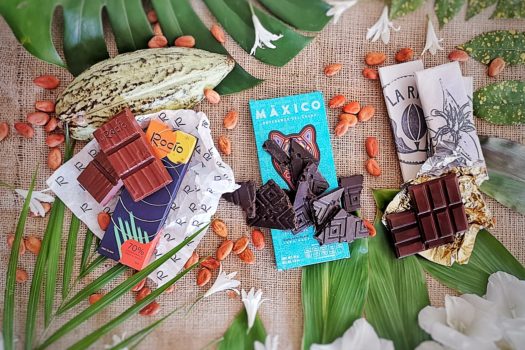LEE ESTA NOTA EN ESPAÑOL AQUI.
Mexico is the birthplace of countless flavors that are known around the world, and chocolate is probably the most beloved of them all. The ancients valued it intensely, they called it “the beverage of the Gods” and cacao beans were used as currency for some time. Much more fun than a pocketful of spare change. While Mexico continues to produce some the world’s best cacao beans, and beautiful rustic, traditional chocolate, it was the Europeans who refined chocolate-making culture to how we understand it today.
Commercially speaking, the country that invented chocolate doesn’t have many respectable confections. There are no Mexican equivalents to a Lindt, a Ghirardelli, or even a Cadbury. For finer chocolate, locals usually rely on prestigious chocolatiers like Dolce Nero, Que Bó, and Tout Chocolat, who are best known for their fancy, filled bonbons. But sometimes, a straight-forward bar is the best way to satisfy the craving. Mexico does have a few craft chocolate makers who are putting out some very memorable bars. Here are three of them that recently captured my choco-attention:
Máxico

Launched in 2019, Máxico Chocolate (pronounced “ma-hee-co” which means “magical”), debuted with three very different bars of Oaxaca-grown Organic grade cacao. The purple box, inspired in Oaxacan traditional chocolate, offers a 70% cacao. What sets this bar apart is the texture, as it makes no pretense of a smooth European-style, keeping the sugar granulated, as it is still made today by Oaxacan artisans.

The turquoise box is a high-end, rather flawless dark chocolate with sea salt, also 70% cacao. The orange box was the most surprising and original of the three. It’s a 50% cacao, loaded with candied sesame seeds. The crunch and the depth the sesame provides is a very unexpected sensation, so I fell madly in love with that one.
La Rifa

Tucked away in the rear of a hipster restaurant is the workshop where one of the finest chocolate bars in Mexico is made: La Rifa. The young team who once worked at the former top-notch cacao project called La Casa Tropical, have now taken the baton and ran with it. They are fastidious about working with farmers, choosing ingredients, playing with fermentation, and making small batches of chocolate bars. Their quality caught the attention of culinary leaders such as Rene Redzepi who sells La Rifa in his renowned restaurant Noma in Copenhagen.

La Rifa chocolate bars are thin, but they are absolutely marvelous. They are wildly expressive. There is a Technicolor landscape of flavors and notes that make this modest-looking bar a very complex choco-experience. They feature various species of cacao, and each bar comes with a card that explains its origins, including the names of the people who cultivated the beans
Chocolate Rocío

“Tree to bar” is the chocolate equivalent of the “farm to table” movement, and another newcomer, Rocío Chocolates, subscribes to that philosophy. In part what this means is that we will get a chocolate bar as close to the source as possible. This young brand focuses on ensuring excellence, qualifies for Organic certification, and also works directly with farmers. But what sets this bar apart is its flavor, and we need to understand what it’s made of. They use a type of bean known as “white cacao”, which is extremely rare in part for being a species that is genetically weaker than most common varieties. Even natural pollination from nearby plants can compromise the white cacao. It’s difficult and expensive to work with, because it produces a very small amount of pods in comparison to the conventional cacao, so that’s why we don’t see much of it on the shelves

Don’t expect a traditional cocoa-y flavor from this bar. It tastes more like deep molasses with tropical fruit undertones, and outstanding creaminess. It took me completely by surprise.
And I’d like to close up with a personal note. The Mexican cacao industry is facing complex challenges on the economic, social and environmental fronts. Part of the solution might be supporting the independent local chocolate makers. So, when given the choice, I’d like to encourage you to purchase artisanal Mexican chocolate bars, whether one of the three mentioned above, or any other you may come across.


Leave a Reply